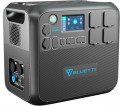Add to comparison |  |  |
|---|---|---|
| BLUETTI AC200MAX | BLUETTI PowerOak EB70 | |
from $995.67 | from $369.00 | |
| User reviews | ||
| TOP sellers | ||
4 USB A ports, 1 USB C port. Car cigarette lighter, DC5521 port. LiPo4 battery. Jumps up to 4800 watts are allowed. Touchscreen. Wireless charging power 15W (2 fields). | 2 USB A ports, 2 USB C ports. Car cigarette lighter port DC5521. Jumps up to 1400 W are allowed. LiFePo4 battery. Wireless charging power 15 W. Flashlight | |
| In box | charging station | charging station |
| Rated power | 2400 W | 1000 W |
| Peak power | 4800 W | 1400 W |
| Output waveform | sinusoid (PSW) | sinusoid (PSW) |
Outputs | ||
| Sockets (230 V) | 4 | 2 |
| USB A | 2 5В/3A 15 W | 2 5В/3A 15 W |
| USB A (quick charge) | 2 5-12В/3A 18 W | |
| USB C | 1 100 W | 2 3 A, 5 A 100 W |
| Wireless charger | 2 zones 15 W | 1 zone 15 W |
| Car cigarette lighter | ||
| Add. ports | 4 pin Aviation Socket | |
Inputs (station charging) | ||
| From solar panels | ||
| DC input | 1 pcs DC7909 | |
Battery and charging time | ||
| Connecting an additional battery | ||
| Battery type | LiFePO4 | LiFePO4 |
| Battery capacity | 2048 W*h | 716 W*h |
| Charging cycles | 3500 | 2500 |
| Charging time (socket) ≈ | 360 min | 240 min |
| Charging time (socket + solar panel) ≈ | 150 min | |
| Charging time (solar panel) ≈ | 210 min | 360 min |
| Charging time (cigarette lighter) ≈ | 480 min | |
| Charging power (socket) | 500 W | 200 W |
| Charging power (solar panel) | 900 W | 200 W |
| Charging power (cigarette lighter) | 100 W | |
| Charging power (socket + solar panel) | 1400 W | |
General | ||
| Smartphone synchronization | Bluetooth | |
| PSU | external | external |
| Display | ||
| Backlight | ||
| Carrying handle | ||
| Operating temperature | -20 °C ~ +40 °C | 0 °C ~ +40 °C |
| Dimensions | 387x420x280 mm | 221x320x216 mm |
| Weight | 28.1 kg | 9.7 kg |
| Warranty | 2 years | 2 years |
| Added to E-Catalog | october 2022 | september 2022 |
Comparing the BLUETTI AC200MAX and BLUETTI PowerOak EB70 charging stations, it can be noted that the AC200MAX is significantly more powerful, with a nominal power of 2400 W and a peak power of 4800 W, while the EB70 has a nominal power of 1000 W and a peak of 1400 W. The AC200MAX offers more outputs, including 4 sockets at 230 V and 5 at 100-120 V, whereas the EB70 has only 2 sockets at 230 V and 2 at 100-120 V. Both devices use LiFePO4 batteries, but the AC200MAX has a larger capacity (40 Ah versus 32 Ah for the EB70) and a higher number of charging cycles (3500 versus 2500). The charging time for the AC200MAX is also faster when using an outlet and solar panels. However, the EB70 is lighter (9.7 kg versus 28.1 kg) and more portable. Users note the high build quality and reliability of both devices, but the AC200MAX is suitable for more serious tasks, while the EB70 is better for light and mobile needs.